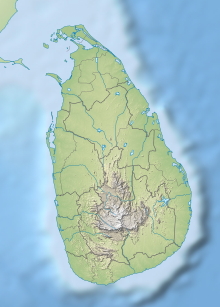Kanneliya–Dediyagala–Nakiyadeniya
| Kanneliya–Dediyagala–Nakiyadeniya | |
|---|---|
| Location | Southern Province, Sri Lanka |
| Nearest city | Galle |
| Coordinates | 6°11′N 80°25′E / 6.183°N 80.417°E |
| Area | 10,139 ha |
| Established | 2004 |
| Governing body | Department of Forest Conservation |
Kanneliya–Dediyagala–Nakiyadeniya or KDN is a forest complex in southern
Physical features
The biosphere consists series of parallel mountain ranges and valleys. The elevation ranges from 60 m to 425 m above sea level.[4] Mean annual temperature is 27.0 °C while annual temperature variation is 4 °C-5 °C. The forest receives a substantial rainfall of 3,750 mm. Many ancient taxonomic groups of Gondwana are present in these rain forests. They also relates to Indomalayan plants and animals.
Hydrological features
The forest complex act as an important
Flora
The KDN forest complex shows a degree of floral
Numerous
Fauna
Some 220 faunal species recorded from the KDN forests and forests around the KDN. recorded in these rain forests.
Human imprint and conservation
10,000 people live in 78 villages around the forest complex.
See also
References
- ^ "UNESCO Protects 19 New Biosphere Reserves". ens-newswire.com. Environment News Service. November 2, 2004. Retrieved 2009-06-09.
- ^ de Livera, Lankika (September 9, 2007). "Regrowing lost Rainforests". The Sunday Times. Retrieved 2009-06-09.
- ^ a b c d e f Bandaratillake, H.M. (2003). "Community participation in the management of the Kanneliya-Dediyagala-Nakiyadeniya proposed biosphere reserve" (PDF). Journal of National Science Foundation of Sri Lanka. National Science Foundation. Archived from the original (PDF) on 2011-07-22. Retrieved 2009-06-09.
- ^ ISBN 955-573-401-1.
- ^ a b Nishantha. "Kanneliya,Dediyagala-,nakiyadeniya reserved Forest". globosapiens.net. globosapiens.net. Archived from the original on 2009-03-28. Retrieved 2009-06-09.
- ^ Olander, S.B. & Wilkie, P. (2019). "Palaquium hinmolpedda". IUCN Red List of Threatened Species. 2019: e.T129335080A129336745. Retrieved 2020-07-13.
- ^ "Kanneliya-Dediyagala-Nakiyadeiya (KDN)". unesco.org. UNESCO. Retrieved 2009-06-09.
- ^ "Sri Lanka's Sinharaja Rainforest Corridor". rainforestrescue.org.au. Rainforest Rescue. Archived from the original on 2009-09-15. Retrieved 2009-06-09.
- ^ "BirdLife IBA Factsheet". birdlife.org. BirdLife International. 2009. Retrieved 2009-06-09.

